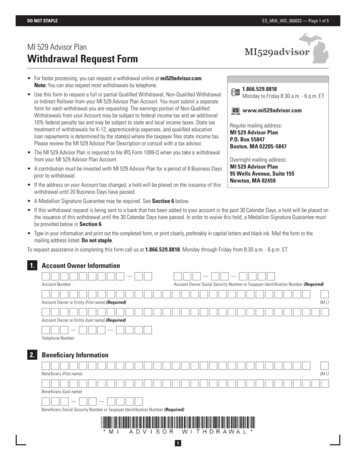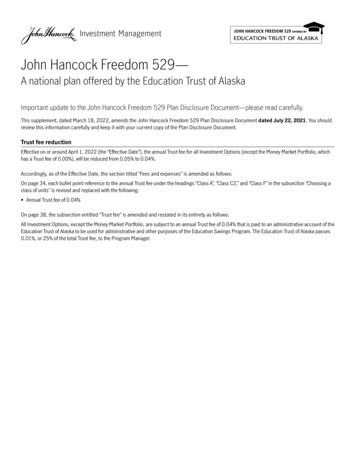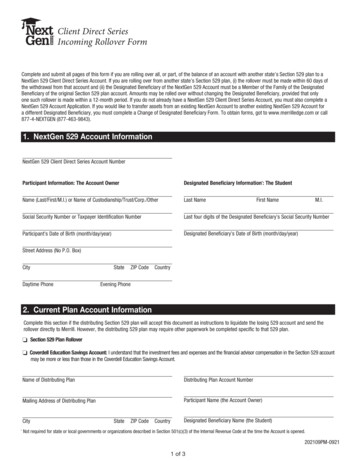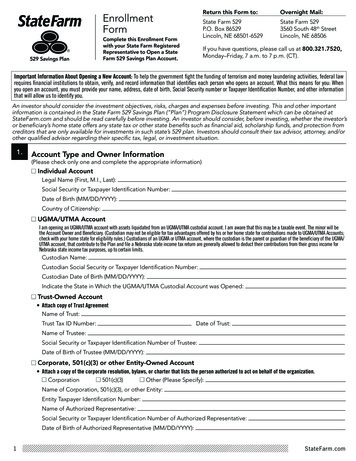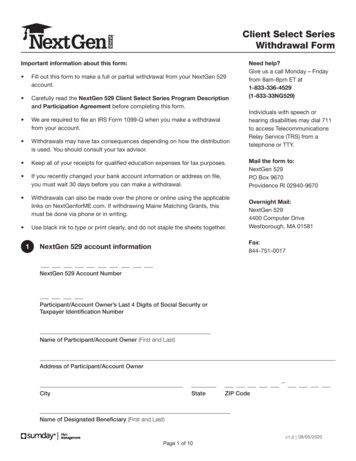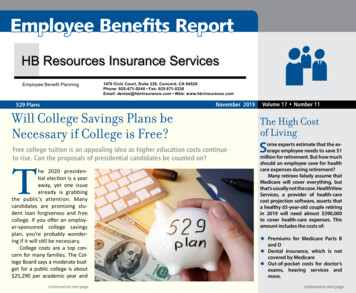
Transcription
Employee Benefits ReportEmployee Benefit Planning1470 Civic Court, Suite 330, Concord, CA 94520Phone: 925-671-0248 Fax: 925 671-0236Email: denise@hbrinsurance.com Web: www.hbrinsurance.comNovember 2019529 PlansWill College Savings Plans beNecessary if College is Free?Free college tuition is an appealing idea as higher education costs continueto rise. Can the proposals of presidential candidates be counted on?The 2020 presidential election is a yearaway, yet one issuealready is grabbingthe public’s attention. Manycandidates are promising student loan forgiveness and freecollege. If you offer an employer-sponsored college savingsplan, you’re probably wondering if it will still be necessary.College costs are a top concern for many families. The College Board says a moderate budget for a public college is about 25,290 per academic year andcontinued on next pageVolume 17 Number 11The High Costof LivingSome experts estimate that the average employee needs to save 1million for retirement. But how muchshould an employee save for healthcare expenses during retirement?Many retirees falsely assume thatMedicare will cover everything, butthat’s usually not the case. HealthViewServices, a provider of health-carecost projection software, asserts thata healthy 65-year-old couple retiringin 2019 will need almost 390,000to cover health-care expenses. Thisamount includes the costs of:Y Premiums for Medicare Parts Band DY Dental insurance, which is notcovered by MedicareY Out-of-pocket costs for doctor’sexams, hearing services andmore.continued on next page
Employee Benefits Report November 2019529 Plans 50,900 for a private college. Unfortunately,most households aren’t equipped to handlethese costs. A Sallie Mae representative estimates that only about 10 percent of familiespay the cost of college out of pocket, while therest borrow or use a combination of resources.Democrats announced several solutions,all government supported programs. For instance, Candidate Sen. Bernie Sanders wouldmake two- and four-year public colleges anduniversities tuition- and debt-free. Sen. Kamala Harris proposes making community collegefree and four-year public college debt-free.Sen. Elizabeth Warren proposed eliminatingtuition and fees at public two-year and fouryear colleges. Former Vice President Joe Bidensuggests streamlining the Public Service LoanForgiveness program, focusing on teachers.Republican President Donald Trump mademajor changes to student loan forgivenessprograms, including eliminating taxing student loan discharge for people who qualify forthe Death or Total and Permanent Disabilityclause (this only applies to loans dischargedafter Jan. 1, 2018, and the provision is set toexpire in 2025). Also, the Tax Cut and Jobs Actof 2017 expanded 529 college savings plansto cover K-12 private school expenses.Parents and students should not rely onpromises of free tuition. They should insteadcontinue saving in plans such as the 529 plan.Even if one of these proposals becomes lawand pays for tuition and fees, students stillshould save money for textbooks or living expenses. If a child decides to not attend college,529 funds can be transferred to different family members or used to pay for graduate school.How a 529 College Savings Plan WorksNearly every state has at least one 529plan that offers a full or partial tax deductionfor residents. Individuals investing in a 529account in their home state can use the fundsto pay for tuition at a qualified school in another state.There are two types of 529 plans: prepaidtuition plans and college savings plans. Prepaid plans allow investors to purchase tuitionat today’s cost — enabling them to lock inthe cost of tuition. The more popular option,a college savings plan, invests contributionsin stocks, mutual funds, and bonds. Becauseearnings are tied to market performance, investment growth is not guaranteed.Contributions to a 529 plan are after-taxdollars and grow tax free. This means thatdistributions are not taxed when the studentwithdraws the funds for qualified expenses.Qualified expenses include tuition at eligiblepublic or private two-year or four-year institutions; books, supplies and equipment (suchas computers and Internet access); as well asreasonable costs for room and board.In 2019, the most an individual can annually contribute to a plan is 15,000 withoutincurring a gift tax liability. 529 plans also canbe bundled — allowing for a 75,000 contribution in one year rather than over a five-yearperiod for gift tax purposes. Individuals alsomay fund multiple 529 plans for different children without incurring gift tax consequences,as long as the annual contribution for any onebeneficiary doesn’t exceed the limit.Employees who are banking on stayinghealthy might be surprised to learn that living longer can increase the amount of moneyneeded for health care costs. The 390,000estimate above does not include long-termcare expenses such as skilled nursing care andrehabilitative services. Average assisted livingstays can run 48,000 annually, according toGenworth Financial.To combat this, encourage your employeesto start saving now or fund a health savingsaccount, if you offer one, because they will beable to withdraw from it during retirement.Another option is for employees to purchase long-term care insurance which reimburses policyholders for services includingbathing, dressing or eating.Employer-sponsored 529 Savings PlansTo encourage employers to offer 529plans, seven states drive participation by offering employers a state income tax credit ordeduction for matching employee 529 plancontributions. States currently participatinginclude Arkansas, Colorado, Illinois, Nebraska, Nevada, Wisconsin and Utah.For an employee to qualify for tax savings,most states require residents to contribute totheir home state’s 529 plan. If the employer offers a 529 plan from a different state, the employee could miss out on potential tax savings.Employees also should know that employer 529 matches are taxed as income andthey will owe both federal and state taxes onthe contributions. That may change, becausefederal legislation is pending to exclude employer 529 plan contributions from the employee’s gross income.
Employee Benefits Report November 2019RetirementWhat a State-Run Retirement PlanWould Mean to Your CompanyThere are many ways to save for retirement but mostAmericans aren’t doing it. Many states are consideringlegislation that could make retirement savings easier.Americans are not saving enoughfor retirement. According toNorthwestern Mutual’s 2019Planning and Progress Study, 15percent of Americans have no retirementsavings. Seventeen percent only have between 1 and 75,000 — which falls short ofthe 1 million some experts recommend.Some state legislators think they have thesolution and are focusing on employers.More than 30 states have considered legislation that would establish a state-run retirement plan. Although only 10 states havepassed legislation that would provide forsome form of state-facilitated or mandatedretirement program for private companiesthat do not sponsor their own qualified retirement plans. Those states are California,Oregon, Illinois, Maryland, Connecticut, NewJersey, New York, Washington, Vermont andMassachusetts. Of those 10 state programs,only Illinois, Maryland and Oregon are actively operating at this time. California’s CalSavers program is scheduled to start in 2020.California employers who have 100 employees or more must be in compliance withthe program by June 30, 2020. The deadlinefor employers with five or more employees isJune 30, 2022.All four states — California, Illinois, Maryland and Oregon — require companies withcertain minimum numbers of employees (between 1 and 25, depending on the state) thatdon’t have employer-sponsored retirementplans to:Y Automatically enroll their employees in aretirement savings program.Y Deduct a set amount from each employee’s check (generally 5 percent of compensation). However, employees can optout of the program.Y Transfer those salary deferrals to a RothIRA program set up by the state for thispurpose.Employers who fail to comply with thesestate-mandated programs could be subject topenalties.Observers estimate that the CalSaversprogram will make retirement plans availableto an additional 7.5 million California employees.Some ConcernsHowever, the results have not been quitewhat participants expected. Oregon’s plan,OregonSaves, enrolled more than 50,000 employee participants in 2018, but the averageaccount balance was less than 500, well below the national average 401(k) account balance of 85,000, according to Cerulli Associates, a research and consulting firm.There are several key differences betweenthese state-sponsored and employer-sponsored plans.For instance, a state-sponsored plan usesone investment firm, while an employersponsored 401(k) utilizes a wide range ofinvestment firms which offer several investment options at various risk levels.continued on next page
Employee Benefits Report November 2019Another key difference is that state-sponsored retirement plans carry a 6,000 annualsalary deferral limit compared to the 2019 19,000 annual salary deferral limit (or 25,000if age 50 or over) of employer-sponsored 401(k)s and 13,000 ( 16,000 if age 50 or over) forSIMPLE IRAs.Most state-sponsored retirement plans useafter-tax dollars, so employees will not get touse the pre-tax benefit. Also, state-sponsoredplans do not have an employer-matching contribution feature, which can quickly boost employees’ savings.Finally, employers who choose to offer astate program will be responsible for performing certain administrative tasks, whereas with a401(k) plan, that work usually is handled by aplan administrator.NAIFA, an organization representing insurance and financial advisors, argues that accessto retirement plans is not the problem. They saythat the marketplace already offers consumersa robust variety of retirement options. Insteadof states spending money on programs, NAIFAwould rather states analyze why people aren’tsaving enough before enacting solutions.Still, government’s interest in these types ofplans continues. The Senate is now reviewingproposed Secure Act legislation, which wouldmake it easier for small businesses to collaborate to offer 401(k) plans. That legislation is currently awaiting consideration by the Senate.If you operate in a state which offers a stateplan and are trying to decide whether an employer-sponsored plan would be a better fit foryour employees, contact us to determine whatplan is best for you.Health Insurance CostsWhat’s Behind the 2020 HealthInsurance Premium Hikes?Founding Father Benjamin Franklin famouslysaid, “ in this world nothing can be said tobe certain, except death and taxes.” If he werealive today, he certainly would have added “andannual health insurance premium increases.”As an employer, you knowthat your health insurancecosts will be higher everyyear. That’s because actuaries base annual health insurancepremiums on a variety of factors:Y InflationY What they predict medical claimsand administrative costs will bebased on the health of the insuredindividuals or groups.Y New federal and state laws, rulesand regulations.Y The cost of developing new medications and medical technologies.The price hikes do add up. According to the National Business Groupon Health, the total cost of workerhealth benefits is expected to increase5 percent in 2020, reaching a high of 15,000 per employee.Here are some of the factors affecting rates and premiums in 2020.continued on next page
Health Insurance CostsRisk Pool CompositionA health insurance risk pool is a group ofpeople whose medical costs are combined tocalculate premiums. Pooling risks allows thehigher costs of those who are not healthy tobe offset by the relatively lower costs of thosewho are healthy. Usually the larger your company is, the more predictable your risks willbe and the more likely your premiums will bestable.Beyond a pool of employees, risk poolcomposition also is affected by the overallmarketplace composition. For 2020, expertsexpect fewer enrollees because of policychanges, such as the elimination of the individual mandate penalty and expanding theavailability of Short-Term Limited DurationInsurance (STLDI), Association Health Plans(AHPs); and Health Reimbursement Arrangements (HRAs).Short-Term Limited Duration Insurance(STLDI) is sometimes called temporary healthinsurance and is designed to help bridge gapsin health care coverage during transitions.These plans are not Affordable Care Act (ACA)compliant plans.The ACA restricted the use and durationof short-term plans. However, the Trumpadministration implemented a new policy in2019 that allows anyone to apply for a shortterm plan and not pay a penalty for not being an ACA-compliant. It also allows a singleplan to extend up to 36 months. There are,however, nine states that don’t allow shortterm plans — New York, New Jersey, Massachusetts, Rhode Island, Vermont, California,Colorado, Hawaii and Washington.Employee Benefits Report November 2019Although employers do not sponsor shortterm plans, the expansion of these planscould affect the premiums you pay for groupcoverage. Short-term coverage generally isonly available to consumers who can passmedical underwriting and is therefore muchless expensive than ACA-compliant coverage.People most interested in these plans areusually those who don’t need full, extensivehealth coverage. The exodus of younger andhealthier individuals from the risk pool canincrease premiums for everyone.Also, short-term plans often are favoredby employees who have lost their jobs sincethese plans are an affordable alternative toCOBRA coverage.Association Health Plans (AHPs) allowsmall businesses, including people who areself-employed, to band together by geography or industry to obtain health care coverage at the same rates as large employers.The Trump Administration broadened theability of AHPs to be treated as large groups,and decided to allow self-employed individuals to join AHPs, giving more small employersaccess to lower rates. However, the futureof these plans is uncertain. A March 2019ruling by the Washington, D.C. Circuit Courtprevents AHPs from enrolling new workingowners or taking advantage of the broadereligibility criteria. The Administration is appealing the ruling.Health Reimbursement Arrangements,also called Health Reimbursement Accountsor HRAs, were designed to give employees,who have traditional health insurance, aneasy, tax-advantaged way to be reimbursedfor their out-of-pocket medical expenses andpersonal health insurance premiums. Regulatory changes, taking effect January 1, 2020,give employees the option to purchase individual market coverage with HRA funds. Theyalso could create an HRA to be used to purchase benefits such as STLDI, dental or visioncoverage. These rules only apply to employers meeting certain conditions.Some observers are concerned that employers who have some unhealthy employeeswill shift them to individual plans and premiums in the individual market could increase.Elimination of the Individual Mandate.The goal of the Affordable Care Act individualmandate was to encourage all Americans toget health insurance in a way that maintainsa stable risk pool. Lower-income individualsreceived subsidies to purchase coverage.However, the Tax Cuts and Jobs Act eliminated the individual mandate financial penalty beginning in 2019. Experts expect premiums to increase because unsubsidizedlower-cost healthy individuals are more likelyto forgo ACA coverage — which will shrinkthe risk pool.The health insurance provider (HIP) fee ispaid by insurers and the cost is passed alongto insurance buyers. The fee was suspendedin 2019. The total amount of the 2020 HIP feeis not known at this time. If there is no HIPfee moratorium in 2020, insurers may includethe cost in their 2020 premiums, which mayincrease premiums 1 to 3 percent.Please contact us if you have questionsabout the pricing of your health care plan.more on next page
Travel InsuranceEmployee Benefits Report November 2019On the Road Again – But With InsuranceDo you know the many benefits of travel insurance?One way to ensure their lives are easier is by providing business travel insurance. While travel insurance policies vary,they usually include:Y Cost of emergency medical evacuations and repatriation coordination. Evacuation from another country can cost hundreds ofthousands of dollars. Evacuation for security reasons also can beexpensive.Y Reimbursement for essentials while the airline searches for lostluggage.Y Medical and dental costs, including locating local medical facilities.This is important if employees travel outside the United Statessince their health insurance might not be valid in other countries.Some health coverage might only operate on a reimbursement basis. This means the employee must pay for treatment out of theirown pockets and wait for reimbursement by their insurance company.Y Trip cancellation coverage for non-refundable expenses when atrip is canceled for a covered reason, such as death in the family orillness.Y Travel delay coverage provides some money for unexpected hotel,dining and transportation when travel is delayed for a covered reason.Y Baggage coverage provides some reimbursement when luggage isirretrievably lost, damaged or stolen.Business travel insurance also can provide emergency travel assistance services, such as locating alternative flights, tracking lost luggage and finding local medical care. Sometimes it can provide business-specific services and obtaining business equipment, translators,drivers and special event tickets.Your business can pay for the coverage outright or employees canpurchase coverage on a per-trip basis and be reimbursed. If the employee purchases the coverage, they should buy it right after makingthe first trip payment. This timing is important because some benefits, including pre-existing medical condition waivers; canceling forany reason and canceling for work reasons; only apply if the policy ispurchased 10 to 15 days from when the trip deposit was made.Please contact us for more information.The information presented and conclusions within are based upon our best judgment and analysis. It is not guaranteed information anddoes not necessarily reflect all available data. Web addresses are current at time of publication but subject to change. Smarts Publishingdoes not engage in the solicitation, sale or management of securities or investments, nor does it make any recommendations on securities or investments. This material may not be quoted or reproduced in any form without publisher’s permission. All rights reserved. 2019Smarts Publishing. Tel. 877-762-7877. http://smartspublishing.com. 30% total recycled fiber. Printed in the U.S. on U.S.-manufactured paper.
How a 529 College Savings Plan Works Nearly every state has at least one 529 plan that offers a full or partial tax deduction for residents. Individuals investing in a 529 account in their home state can use the funds to pay for tuition at a qualified school in an-other state. There are two types of 529 plans: prepaid

